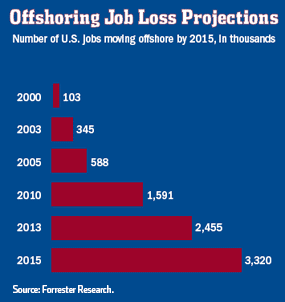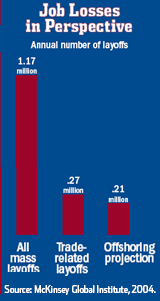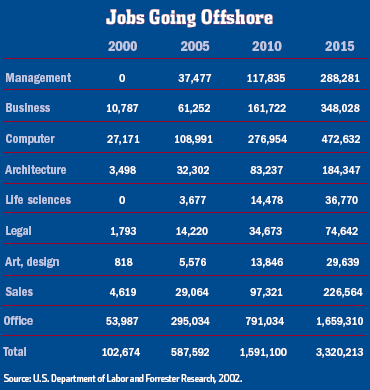 The debate over offshoring white-collar jobs is red hot. Dissecting the rhetoric and grounding the predictions will help HR plan for future workforce needs.
The debate over offshoring white-collar jobs is red hot. Dissecting the rhetoric and grounding the predictions will help HR plan for future workforce needs.
Hark back to 1992 when the presidential election was in full swing. The economy was slowly clawing its way out of a downturn, the United States had just ended a war with Iraq and globalization was threatening the future of manufacturing jobs.
Fast-forward to 2004, and not much has changed. Except now globalization is threatening the future of white-collar jobs, which are increasingly being exported to India and other parts of the globe where highly trained, highly educated workers can perform the same jobs as U.S. workers at nearly half the cost.
And that anxiousness felt among U.S. workers and politicians about the future of job growth and economic viability remains just as palpable as it did in 1992—if not more so.
There’s no denying that the dam has broken on business process offshoring (BPO). Nearly every major U.S. company is offshoring or considering it for one or more functions. Technological advances now allow remote capabilities for almost any type of business process—accounting, computer programming, and some legal and medical services.
The McKinsey Global Institute reports that in 2002, offshoring was worth between $32 billion and $35 billion and estimates those figures represent just 1 percent of the $3 trillion in business functions that could be performed overseas. The market is projected to grow 30 percent to 40 percent annually over the next five years, making offshoring an industry worth well over $100 billion in annual revenue by 2008.
Graham S. Toft, a senior fellow and director of the Center for Economic Competitiveness at Hudson Institute in Indianapolis, says three factors have led to the rise in offshoring: The educational systems of the less-developed world have improved dramatically over the past few decades; investment capital to both China and India is on the move in support of existing or new businesses; and corporations are facing pricing pressures due to an increasingly competitive global marketplace.
John Sullivan, professor of management at San Francisco State University, says this global shift could mean a radical change for HR. “To compete around the world, you have to get talent from around the world,” Sullivan says. “To keep your company strong, you can’t protect your U.S. jobs.”
Much has been said and written—especially in this election year—about the future of offshoring and what it means for the U.S. economy. Cutting through the vitriol and putting the predictions of offshoring’s economic effect into context will help HR prepare for its future workforce needs and business strategy.
Open for Debate
Offshoring in the late 1980s and 1990s was most common in manufacturing, but the new millennium has seen a dramatic rise in the movement of white-collar jobs to countries with highly educated, English-speaking labor forces who will work for a fraction of the pay of U.S. workers.
The largest offshoring market remains India, which accounts for as much as 90 percent of the industry, although other growing markets include the Philippines, Russia, China, Mexico, Brazil and Hungary, according to a June 2003 report by Chicago-based Aon Trade Credit.
Critics of the offshoring trend say the United States stands to lose countless high-paying jobs, technical knowledge and innovative capacity by employing and training workers in foreign countries, rather than advancing the nation’s own workforce.
Indeed, U.S. job losses for white-collar workers could be astounding if certain predictions hold true and if job creation doesn’t keep pace. Causing a stir that has not died down, Forrester Research released a report in 2002 predicting that 3.3 million service industry jobs and $136 billion in wages would move offshore over the next 15 years.
 The report prompted a contentious debate in what has become a major election issue this year. Sen. John Kerry, D-Mass.—the leading Democratic Party presidential candidate—has repeatedly referred to CEOs who send work offshore as “Benedict Arnolds.”
The report prompted a contentious debate in what has become a major election issue this year. Sen. John Kerry, D-Mass.—the leading Democratic Party presidential candidate—has repeatedly referred to CEOs who send work offshore as “Benedict Arnolds.”
Similar rhetoric is being heard in various state legislatures where more than a dozen bills are being considered. On the federal level, President Bush signed an appropriations bill in January that contained an amendment forbidding certain government agencies from offshoring work.
On the other side of the debate, some argue that white-collar offshoring is a natural evolution of a global economy that will help—not hurt—the United States and its workforce. Research shows that, in some cases, corporations can save as much as 60 percent in costs and, by capitalizing on time zone differences, speed up production considerably.
For instance, software development now can follow the sun 24 hours a day. Code is developed in the United States during regular work hours, then follows the time zones to India, on to Europe and back to the United States for the beginning of the next 24-hour period.
Proponents argue that these and other benefits of offshoring will make companies more profitable and will lead to higher-level, higher-paying jobs for U.S. workers. A recent study by the McKinsey Global Institute estimated that of the $1.45 to $1.47 of value that is created globally from every dollar spent offshoring, the United States captures $1.12 to $1.14 while the receiving country captures on average 33 cents. This value is translated from cost savings into reinvestment for company research and development that leads to jobs that are higher-paying than those lost.
McKinsey used Bureau of Labor Statistics data to predict some of the replacement jobs that could be created in industries such as nanotechnology, health care services for the aging population, and media and entertainment. McKinsey’s report, “Who Wins in Offshoring?” predicts that the United States will create some 22 million new jobs in the same period over which offshoring activities will transplant 3 million jobs. “The net effect will be a gain of 20 million [U.S.] jobs,” it states.
Toft puts the debate in perspective by pointing out that there was great concern about the loss of manufacturing jobs starting in the ’70s. “Doomsayers were worried about the decline of the U.S. standard of living, yet, over the last 20 years, the U.S. economy and living standards have improved markedly.”
Likewise, experts predicted doom-and-gloom during the North American Free Trade Agreement (NAFTA) talks, but the economy soared post-1992.
The current trend does differ, however, because trade policies aren’t driving job relocation. Offshoring is “a more general, long-term and permanent shift to the dispersion of production, whereas NAFTA provided just a one-time shift,” Toft says.
Because it’s expected to be an ongoing, steady movement of jobs, the offshoring trend is affecting labor force shortage estimates. While Hudson Institute and others in the 1990s predicted a skills and job shortage in the United States despite the recent downturn and so-called “jobless recovery,” those predictions may be rethought. If so, a looser labor market would benefit U.S. companies.
“Outsourcing, or transnational activity, is becoming a viable way to get access to the large and increasingly skilled worker pool of the developing and newly industrialized countries,” says Toft. “Changes in immigration laws could moderate the use of this strategy. The situation is very fluid; that’s why Hudson cannot speak with as much certainty about U.S. labor shortages this decade. Some other sources still hold strongly to the shortages theory.”
Mixed Bag of Success
Aon Trade Credit says employing low-cost foreign labor has benefits other than cost reduction, since BPO clients often commend the skill and motivation of foreign workers. A survey by Forrester Research found 71 percent of respondents rated their offshore providers as achieving better quality and timeliness than their U.S. providers.
 However, perceived rewards of offshoring are “only half the story,” cautions the Aon report. Some of the most popular countries for offshoring—India, Brazil, the Philippines and Russia—are known for instability or military tensions, and geopolitical risks were the greatest concern (27.3 percent) in a survey of more than 5,000 U.S. and European IT and BPO clients by NeoIT, an offshore advisory and management firm based in San Ramon, Calif., that focuses on IT and business process services. Other concerns included infrastructure (18.2 percent), variable labor costs (14.6 percent), legal framework (10.9 percent) and cultural compatibility (9.1 percent.)
However, perceived rewards of offshoring are “only half the story,” cautions the Aon report. Some of the most popular countries for offshoring—India, Brazil, the Philippines and Russia—are known for instability or military tensions, and geopolitical risks were the greatest concern (27.3 percent) in a survey of more than 5,000 U.S. and European IT and BPO clients by NeoIT, an offshore advisory and management firm based in San Ramon, Calif., that focuses on IT and business process services. Other concerns included infrastructure (18.2 percent), variable labor costs (14.6 percent), legal framework (10.9 percent) and cultural compatibility (9.1 percent.)
The risks don’t stop there. The Gartner Group has compiled numerous risks, including cultural misunderstandings, infrastructure failures, security and privacy violations such as theft of customer credit card numbers, inadvertent knowledge transfer, and contract and liability issues in foreign legal systems, the Aon report says.
Some organizations may need to add political fallout to that list. For example, the state of Indiana canceled a $15 million contract to offshore the administration of unemployment benefits to a BPO vendor in India after bowing to pressure by critics who argued that state taxpayers should not pay for jobs held by foreign workers.
Other organizations may experience reduced quality or other problems that make offshoring unprofitable. Several municipalities and companies, including Lehman Brothers and computer maker Dell Inc., have severed offshore agreements because savings didn’t materialize or they were unsatisfied with services, Toft adds.
In December, Lehman canceled its contracts with two Indian outsourcing firms that handled internal IT help desk requests because the “Indian firms could not provide the level of quality and services Lehman needs,” wrote Louis Miscioscia, a Lehman IT services analyst, as first reported by the Associated Press. Lehman did not return calls to HR Magazine to comment further.
Likewise, Dell rerouted corporate customer calls from an Indian call center back to the United States after receiving numerous service complaints.
However, these and other examples of offshoring “backlash” do not signal an end to the trend. In fact, both Dell and Lehman continue to offshore other pieces of their business.
Indeed, the trend seems far from abating. In a recent survey, 88 percent of 165 senior executives predicted that 2004 will see an increase in outsourcing jobs overseas by U.S. companies, according to Christian & Timbers, a New York-based global retained executive search firm. Of those polled in the January survey, 7 percent said the level of outsourcing will remain the same, while only 5 percent predicted a decrease.
HR’s Role
If the offshoring phenomenon is inevitable, as it appears to be, then HR professionals must keep fully abreast of the issues. In the past, management may have dictated where to place international operations, but by acting as a talent manager, HR is taking the lead by identifying where high-quality, low-cost talent is located—and which countries have favorable business climates that include flexible labor laws and little union activity, Sullivan says.
“I get calls all the time from people being given the responsibility to make their HR department or recruiting department global, and it has to be done in six months,” Sullivan says. “They say, ‘What are the steps?’ ”
Sullivan says HR must become an expert in the areas where the talent is and avoid following the crowd without good cause. India, for example, is potentially volatile given its relationship with neighboring Pakistan, and is becoming less desirable as labor costs rise; yet it’s still the choice for many who are following the herd.
New York-based Cornell University professor Patrick Wright says deciding whether to offshore, where to do it and how to implement it requires a clear delineation of goals and a discussion within the company of financial, strategic, ethical, social and legal issues.
HR’s voice in this discussion, according to Mike Klein, executive director of the Human Resources Practice of the Corporate Executive Board in Washington, D.C., requires a firm understanding of tradeoffs associated with attracting, engaging and developing and retaining offshore employees.
The analysis involves comparing data about wage rates, productivity, working conditions and local leadership in the workplace. “There are a lot of downsides to moving operations offshore, not the least of which is adequately trained local supervisors who can direct and motivate front-line workers while at the same time being attuned to corporate vision and goals,” Toft says.
 Such hidden costs must be factored into the overall cost-benefit formula. “Employees may have the core technical skills, but companies’ abilities to support them and get full value from those skills differ greatly,” says Klein. “These would include such things as the company’s effectiveness at managing teams, managing remote work challenges in general, creating performance management systems and development paths that recognize the unique skills that diverse workers bring to the table, and so on. Beyond employees’ ability to do the core job to the proper level of technical proficiency, these are all critical to realizing high levels of performance.”
Such hidden costs must be factored into the overall cost-benefit formula. “Employees may have the core technical skills, but companies’ abilities to support them and get full value from those skills differ greatly,” says Klein. “These would include such things as the company’s effectiveness at managing teams, managing remote work challenges in general, creating performance management systems and development paths that recognize the unique skills that diverse workers bring to the table, and so on. Beyond employees’ ability to do the core job to the proper level of technical proficiency, these are all critical to realizing high levels of performance.”
Infrastructure to support the offshore operation also should be taken into account.
Offshoring will require both money and strategy to minimize turnover in increasingly competitive labor markets such as India. “It’s going to be like Silicon Valley in the 1990s,” Klein says. “These people know they’re hot, and they’ll have a lot of options.” NeoIT notes that while turnover for call centers in India is lower than those in the United States, it is on the rise.
The 40 percent to 60 percent savings projections that BPO vendors tout also don’t factor in costs for vendor selection, work transition and set-up, layoffs and retaining existing employees, lost productivity and cultural issues, along with the price to improve development processes and do contract management. All can cut 15 percent to 57 percent from expected savings, Wright says.
While proponents claim a company will reap a stronger talent pool, greater global presence, quicker production cycles and higher quality, HR and other company leaders need to consider the less desirable effects of offshoring, Wright says. Those include the loss of knowledge that goes with the displaced workers, impediments to sharing information and knowledge among employees offshore and, in the United States, the possible demoralizing effect on your remaining workforce as well as the risk of creating a negative corporate brand image.
In addition, offshoring might result in the loss of federal government contracts, increased litigation over lost U.S. jobs, protectionist legislation and questions over intellectual property rights.
Put simply, Wright says: “If you’re only chasing after labor costs [savings], you may be able to move to China and get the lowest cost programmers today, but do they have the skills and ability to innovate and share knowledge with the rest of your workforce?”
Ultimately, HR must find the answers and address the issues that come with offshoring, Wright says, because it’s going to increase. Protectionist legislation might slow it, but, in the long term, he says, it will just make the United States non-competitive.
“In the end, someone will propose to outlaw this activity, which is like outlawing gravity,” Wright says. “You can’t do it. You can whine about it all you want, but it’s a force that’s not going to be stopped.”
Pamela Babcock is a freelance writer based in the New York City area. She has worked as a reporter for The Washington Post and the News & Observer in Raleigh, N.C., as well as in corporate communications.Advertisement
An organization run by AI is not a futuristic concept. Such technology is already a part of many workplaces and will continue to shape the labor market and HR. Here's how employers and employees can successfully manage generative AI and other AI-powered systems.
Advertisement


